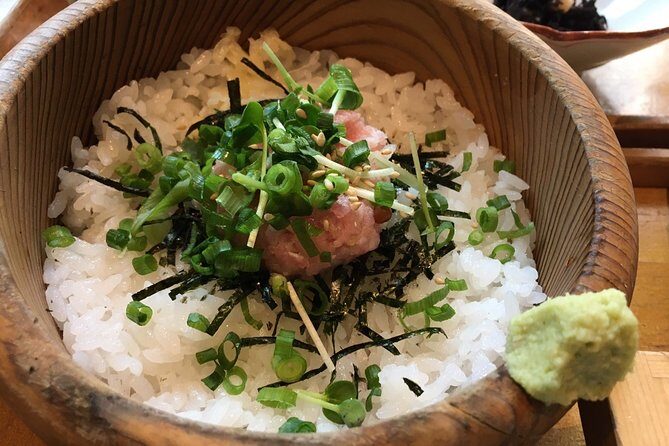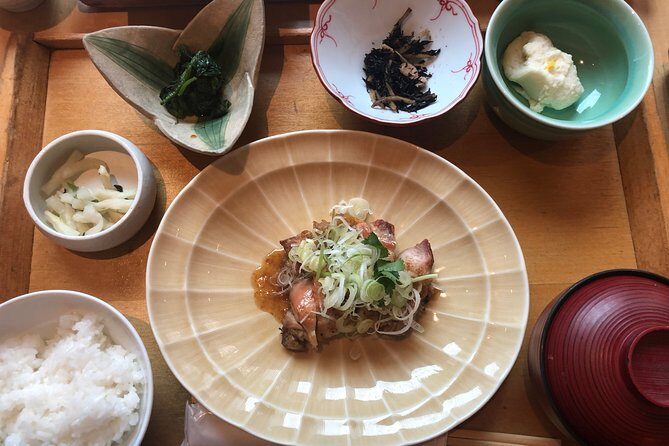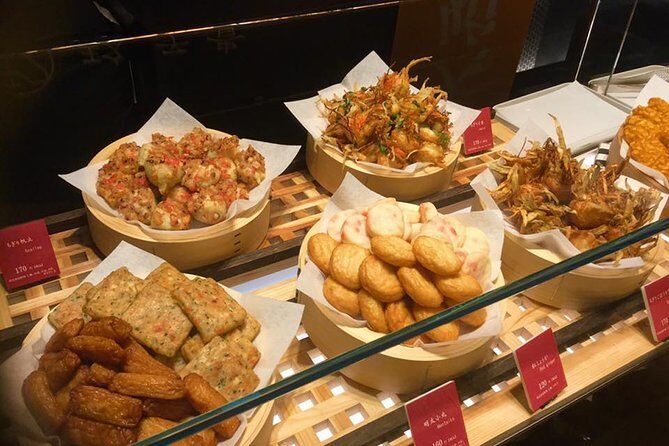A Tasty Journey through Tokyo’s Food Scene

When we think of exploring Tokyo, it’s tempting to focus only on its famous sights, but a food tour like Flavors of Japan offers a completely different perspective. For $209 per person, you spend around three hours strolling through Nihombashi, visiting nine food stops that highlight Japan’s regional cuisines, iconic ingredients, and culinary traditions. Led by friendly, knowledgeable guides, this tour is tailored for those eager to understand what makes Japanese cuisine so beloved worldwide.
What we loved about this experience is how it combines walking, tasting, and learning into a compact, engaging package. First, the stops are thoughtfully selected—ranging from tiny, historic shops to modern markets—and each introduces a different aspect of Japan’s culinary landscape. Second, the lunch at the end isn’t just a quick bite; it’s a carefully chosen set meal that showcases staples like soba, tempura, sashimi, or grilled fish, giving us a satisfying conclusion to a flavorful journey.
A potential consideration for travelers is the walking component—while manageable for most, those with mobility issues or heavy luggage might find the pace a bit brisk. Also, though the tour is family-friendly, children must be accompanied by an adult, and for kids over 10, a passport copy is required. The tour suits food lovers, curious travelers, and anyone who wants to see Tokyo through its culinary lens, with genuine insight and plenty of delicious bites along the way.
Key Points

- Authentic regional flavors: Tastes from across Japan, not just Tokyo, are showcased.
- Expert guidance: Knowledgeable guides make learning about Japanese cuisine fun and accessible.
- Diverse stops: From sweets to seafood and tea, each location offers a unique experience.
- Full lunch included: A well-rounded meal provides a satisfying end to the tour.
- Flexible and family-friendly: Suitable for most travelers, with options for pescetarians, vegans, and vegetarians.
- Convenient meeting point: Starts near public transportation in Nihombashi.
Keen to taste more of Tokyo? We've looked into these other food and drink experiences
Exploring Tokyo’s Culinary Landscape: An In-Depth Review
What’s Included and What’s Not
This tour offers regional food tastings, one drink, a guided experience, and a traditional Japanese lunch. The price reflects solid value, especially given the multiple stops and the lunch. However, it does not include transportation to or from the meeting point, nor additional drinks or snacks. If you’re planning a day in Tokyo, you’ll want to factor in the cost of getting there and back.
How the Tour Is Structured
Meeting at Starbucks Coffee in the Nihombashi Suruga Building, you’ll start your culinary journey at 10:30 am. The tour’s design is well thought out: it combines walking through historic neighborhoods, visiting shops, and sampling regional delicacies. You’ll explore Nihonbashi, Suitengu Shrine, Nihonbashi Bridge, and more, making it as much a cultural walk as a food adventure.
The Stops: What You’ll Experience
Stop 1: Starbucks at Nihombashi Suruga Building — An easy, central meeting point that signals the start of an adventure through Tokyo’s food scene. This initial gathering sets a relaxed tone before heading into the culinary highlights.
Stop 2: Nihonbashi — Here, guides share insights into local life while you sample seasonal dishes, regional snacks, and watch artisans craft traditional wagashi (Japanese sweets). This stop is a highlight, especially for sweet enthusiasts, because the guides often describe the artistry behind wagashi and its significance.
Stop 3: COREDO Muromachi 1 & 2 — Visiting these modern shopping complexes, you can see how traditional and contemporary Japanese food culture blend. The guides might explain what makes Japanese cuisine unique and delicious, emphasizing the building blocks like dashi (soup stock) and pickled vegetables.
Fukutoku Shrine, Nihonbashi Takashimaya, Suitengu Shrine — These stops offer a glimpse into Tokyo’s historic districts, where you’ll find shops that have been around for hundreds of years, and where you might see craftsmen making fish cakes from Kagoshima or other regional specialties.
Nihonbashi Bridge — An iconic spot, perfect for a photo and some reflection on how Tokyo’s culinary history converges here.
While in Tokyo, here are other experiences we've covered
The Food Tastings: A Deep Dive
Throughout the tour, you’ll sample an assortment of local and regional dishes. Highlights include Dashi (the fundamental soup stock that flavors much of Japanese cuisine), egg roll (Tamagoyaki), fish cakes, eel sushi, and green teas. Each bite is an opportunity to understand what makes Japanese ingredients so versatile and flavorful.
The guides are adept at explaining how each dish is made and why it’s important in regional cuisine. For example, the regional snacks and satsuma imo (fried sweet potatoes) are more than just tasty—they’re a window into local customs and agricultural traditions.
The Lunch: A Fitting Finale
After sampling numerous small bites, the final stop is a full Washoku lunch. Choices often include soba, tempura, sashimi sets, grilled fish, chicken, or sukiyaki, with options to suit pescetarians, vegetarians, and vegans. This meal helps you appreciate the variety and balance of Japanese cuisine, and it’s served in a relaxed setting where you can chat with your guides and fellow travelers about what you’ve learned.
Post-Lunch Exploration: Depachika Market
Following the meal, you’re encouraged to visit the Depachika, an underground food market packed with snacks, sweets, and ingredients. Your guide points out the best places to buy after-lunch treats, and you’re free to explore on your own. This segment is perfect for those wanting to continue snacking or pick up souvenirs.
What Reviewers Say
Multiple reviews praise the knowledgeability of guides and the variety of food. Louis D called it “a wonderland of food,” appreciating how the guides made him feel more comfortable tackling Japanese menus afterward. Many travelers highlight the stunning views and traditional sweets as memorable parts of the experience.
The Pros and Cons
The main advantage of this tour is its balance of education and tasting. You don’t just eat—you learn about regional ingredients, food traditions, and cultural insights. The small group size (max 10 travelers) ensures personalized attention, and the family-friendly approach makes it suitable for most ages.
On the downside, walking 3 hours may be tiring for some, especially during hot or rainy weather. Also, the tour’s success depends on restaurant schedules and availability, so some stops or dishes might vary.
Who Is This Tour Best For?
This experience is perfect for food lovers, culture enthusiasts, and first-time visitors who want an authentic taste of Tokyo’s culinary scene. It’s also well-suited for those interested in regional Japanese ingredients and traditional sweets. If you’re traveling with family or friends eager to share a culinary adventure, this tour offers a fun, educational bonding experience.
Final Thoughts

The Flavors of Japan Food Tour in Tokyo offers a well-organized, authentic, and delicious introduction to Japanese cuisine. It’s a fantastic way to see the city through a different lens—one of taste, tradition, and local craftsmanship. You’ll leave with a deeper understanding of what makes Japanese food so globally popular and, more importantly, with your stomach happily satisfied.
Whether you’re a food rookie or a seasoned gourmand, this tour provides a meaningful glimpse into Japan’s regional flavors. The experience is rich in insights, flavors, and fun, making it a great addition to any Tokyo itinerary.
Frequently Asked Questions

How long is the tour?
It lasts approximately 3 hours, including stops, tastings, and the lunch.
What is the meeting point?
You meet at Starbucks Coffee in the Nihombashi Suruga Building, near public transportation.
Are drinks included?
Yes, one drink is included as part of the experience.
Can I participate if I have dietary restrictions?
Yes, the tour is pescetarian, vegan, and vegetarian friendly, with options available upon booking.
Is the tour suitable for children?
Yes, it’s family-friendly, but children over 10 require a passport copy and must be accompanied by an adult.
What should I wear?
Comfortable walking shoes are recommended, as you’ll be walking for about three hours.
Is this a good experience for solo travelers?
Absolutely. Small groups foster a friendly atmosphere, and guides are great at engaging everyone.
Can I cancel if my plans change?
Yes, free cancellation is available up to 24 hours before the tour.
Will I get to see traditional Japanese sweets being made?
Yes, part of the tour includes watching artisans craft wagashi desserts.
Is the tour rain or shine?
Most weather conditions are manageable, but if canceled due to poor weather, you’ll be offered a different date or full refund.
In the end, this food tour is a delightful, authentic way to taste Japan’s culinary diversity. It’s perfect for those who want more than just sightseeing, craving an experience that feeds both mind and stomach.
More Food & Drink Experiences in Tokyo
- Shinjuku Local Food and Sake Tour
- Private Sake Tasting at 300 Years Old Sake Brewery in Tokyo
- Private Tokyo Local Food and Drink Tour with a Bar Hopping Master
- Tsukiji Fish Market Private Food Tour in Tokyo
- Wagyu Beef & Sake Pairing Foodie Tour in Tokyo
- Shibuya All You Can Eat Best Food Tour The Original One in Tokyo
More Tours in Tokyo
- Private Custom Tour: Tokyo in a Day
- Mt Fuji Exploration Tour with Free Japanese Kusa Mochi from Tokyo
- Mount Fuji and Hakone Private Tour with Pickup from Tokyo
- Mount Fuji Day Tour by Chartered Car
- Shinjuku Kabukichou local areas Exploring Tour in Bar or Hot Bath
- Tokyo Private Tour by Vehicle with English-Speaking Chauffeur
More Tour Reviews in Tokyo
- Private Custom Tour: Tokyo in a Day
- Mt Fuji Exploration Tour with Free Japanese Kusa Mochi from Tokyo
- Mount Fuji and Hakone Private Tour with Pickup from Tokyo
- Mount Fuji Day Tour by Chartered Car
- Shinjuku Kabukichou local areas Exploring Tour in Bar or Hot Bath
- Tokyo Private Tour by Vehicle with English-Speaking Chauffeur
More Tokyo experiences we've covered
- Private Custom Tour: Tokyo in a Day
- Mt Fuji Exploration Tour with Free Japanese Kusa Mochi from Tokyo
- Mount Fuji and Hakone Private Tour with Pickup from Tokyo
- Mount Fuji Day Tour by Chartered Car
- Tokyo Kichijoji Twilight: Explore Instagram-Worthy Hidden Spots
- Shinjuku Kabukichou local areas Exploring Tour in Bar or Hot Bath
- Tokyo Private Tour by Vehicle with English-Speaking Chauffeur
- Mount Fuji Day Trip Around Lake Kawaguchiko
- “Ginza Tsukishima” Walking and Japanese Style Fun Dining Tour
- Shinjuku Local Food and Sake Tour
- Tokyo Vegan Gourmet Tour A Culinary Journey
- 2 – Hour Private Walking Tokyo Photoshoot
